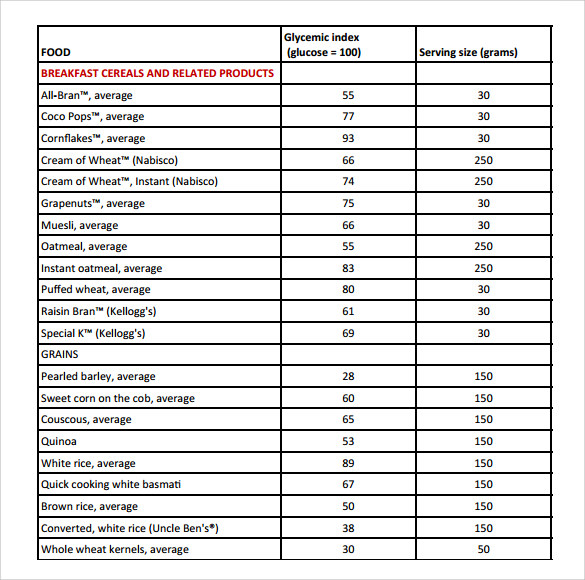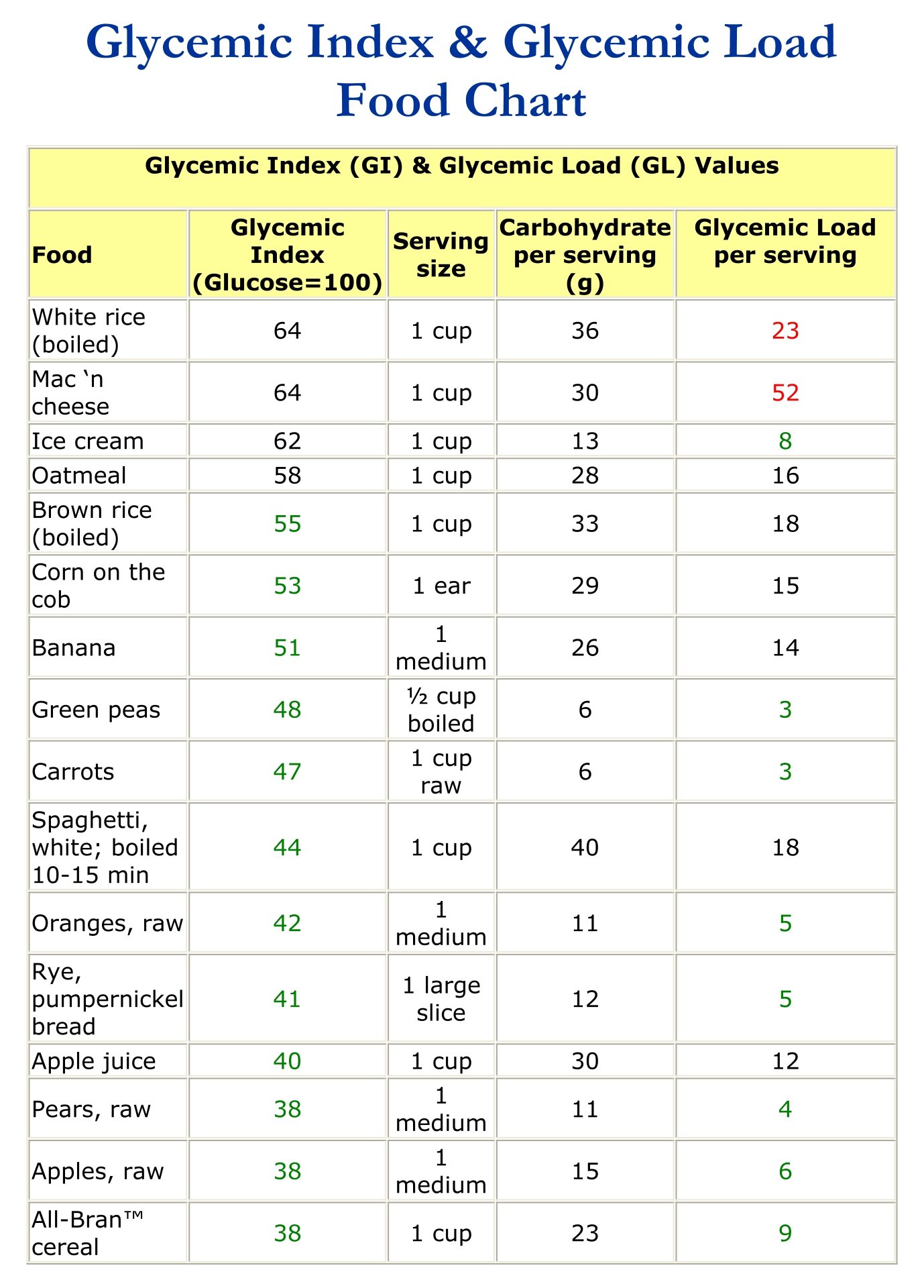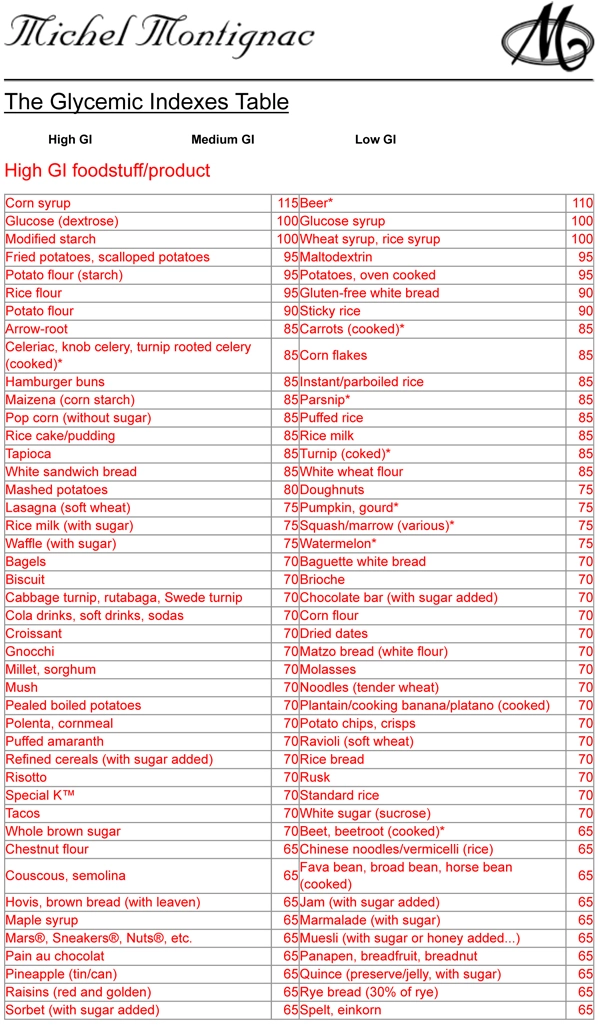Printable Glycemic Load Chart - Web the glycemic load (gl) is a relatively new way to assess the impact of carbohydrate consumption on the rise of blood sugar in the body. It is a sign of the quality of carbohydrates in the food. Foods low on the glycemic index (gi) scale tend to release glucose slowly and steadily. Web to help you understand how the foods you are eating might impact your blood glucose level, here is. Web the glycemic index, or gi, uses a scale of numbers from 1 to 100 to rank carbohydrate foods by how quickly a serving size of each raises blood sugar. 56 to 69 high gi: The high end of the scale has foods with a big effect on blood sugar levels. High = 20 or more. The glycemic index ranks food on a scale from 0 to 100. Complete up to date table of glycemic index values collected from all.

Chart of the glycemic index and glycemic load of popular foods
Because carbohydrates, or carbs, such as rice, pasta, bread, and fruit, raise blood sugar more, and more quickly, than fats or proteins do. The glycemic index (gi) assigns a numeric score to a food based on how drastically it makes your blood sugar rise. Web updated on october 4, 2021. Web the glycemic index, or gi, uses a scale of.

FREE 7+ Sample Glycemic Index Chart Templates in PDF
Web a gl below 10 is considered “low”, from 11 to 19 “moderate”, and above 20 is “high” (see table 1). The gl of a food is calculated by multiplying the gi of that food by the amount of carbohydrate in an actual serving of the food. Web the glycemic index, or gi, uses a scale of numbers from 1.

Alfa img Showing > Glycemic Index Chart PDF Low glycemic index
The low end of the scale has foods that have little effect on blood sugar levels. Web glycemic index (gi) & glycemic load (gl) values food glycemic index (glucose=100) serving size carbohydrate per serving (g) glycemic load per serving high: The glycemic load (gl) adds the amount of carbohydrate (quantity) into the. Eating foods with a lower gi may result.

Glycemic Index and Glycemic Load Diets Nutritional Medicine
Complete up to date table of glycemic index values collected from all. The low end of the scale has foods that have little effect on blood sugar levels. The gl of a food is calculated by multiplying the gi of that food by the amount of carbohydrate in an actual serving of the food. A low gi is a sign.

2 Glycemic index (GI) of carbohydraterich foods and their glycemic
Foods are ranked on a scale of 0 to 100, with pure glucose (sugar) given a value of 100. Remember, the lower the glycemic load for a food, the lower the rise in. Eating foods with a lower gi may result in a more gradual rise in your blood sugar level. Web ajcn publishes “international tables of glycemic index and.

10 Best GI Of Food Chart Printable
Complete up to date table of glycemic index values collected from all. Web the glycemic index, or gi, uses a scale of numbers from 1 to 100 to rank carbohydrate foods by how quickly a serving size of each raises blood sugar. 56 to 69 high gi: The gl of a food is calculated by multiplying the gi of that.

301 Moved Permanently
The glycemic index ranks food on a scale from 0 to 100. It gives a fuller picture than gi alone. Generally speaking, the ranking for glycemic load is as follows: Because carbohydrates, or carbs, such as rice, pasta, bread, and fruit, raise blood sugar more, and more quickly, than fats or proteins do. Complete up to date table of glycemic.

Glycemic Load Chart Pdf Resume Examples
Web the glycemic load (gl) is a relatively new way to assess the impact of carbohydrate consumption on the rise of blood sugar in the body. Web in general, a low glycemic load is 10 or less, a medium gl is 11 to 19, and a high gl is. Foods low on the glycemic index (gi) scale tend to release.

Pin on How to improve your diet and nutrition
The glycemic index (gi) assigns a numeric score to a food based on how drastically it makes your blood sugar rise. Because carbohydrates, or carbs, such as rice, pasta, bread, and fruit, raise blood sugar more, and more quickly, than fats or proteins do. Foods with a high glycemic index value tend to raise your blood sugar higher and faster.

Glycemic Index Glycemic Load GIGL Food Chart
Eating foods with a lower gi may result in a more gradual rise in your blood sugar level. The glycemic index is a system of ranking foods on a scale of 0 to 100 according to how high blood glucose peaks within two hours of consuming the specific food. High = 20 or more. Web the glycemic index, or gi,.
70 to 100 the following charts highlight low, medium, and high gi foods based on data from the american diabetes association. Gl = 46 x 12 ÷ 100 = 5.52. Web a printable low glycemic food chart is a helpful tool for those who are looking to maintain stable blood sugar levels and make healthier food choices. Low gl meals are recommended for weight loss and better blood sugar control. The glycemic index ranks food on a scale from 0 to 100. Web the glycemic index, or gi, uses a scale of numbers from 1 to 100 to rank carbohydrate foods by how quickly a serving size of each raises blood sugar. Gl uses gi and the amount of total carbohydrates per serving of a specific food to estimate both how quickly a food causes blood sugar to rise and how much blood. Web the glycemic index is a value assigned to foods based on how quickly and how high those foods cause increases in blood glucose levels. Eating foods with a lower gi may result in a more gradual rise in your blood sugar level. It gives a fuller picture than gi alone. Foods low on the glycemic index (gi) scale tend to release glucose slowly and steadily. Web low glycemic index (55 or less) choose most often medium glycemic index (56 to 69) choose less often high glycemic index (70 or more) choose least often almond milk cow milk (skim, 1%, 2%, whole) frozen yogurt greek yogurt soy milk yogurt (skim, 1%, 2%, whole) additional foods: Remember, the lower the glycemic load for a food, the lower the rise in. Web glycemic index vs. The glycemic index (gi) assigns a numeric score to a food based on how drastically it makes your blood sugar rise. It is a sign of the quality of carbohydrates in the food. The low end of the scale has foods that have little effect on blood sugar levels. The glycemic load (gl) adds the amount of carbohydrate (quantity) into the. All of the foods listed here are lower to medium gi and gl. Web a gl below 10 is considered “low”, from 11 to 19 “moderate”, and above 20 is “high” (see table 1).